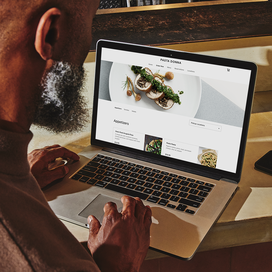Table of contents
Pop-up shops are no longer just a trend: The pop-up industry has grown to reach an estimated market size of $14 billion, and brands ranging from Nordstrom to Sprite are hosting pop-ups of their own to create a new kind of customer experience.
These in-person, customer-driven events can help a business take its marketing and sales tactics to the next level, no matter how big or small. Here’s what to know about pop-ups, the different forms they come in, and how to open a pop-up shop yourself.
What is a pop-up shop?
A pop-up shop (sometimes referred to as a pop-up store or flash retailing) is a temporary storefront that’s intended to attract a high volume of customers over a short period of time. These physical locations can range from brick-and-mortar spaces to market stalls, and because they aren’t meant to be permanent, they work well for generating brand awareness or introducing new products.
Some of the benefits of a pop-up shop include:
- Engaging with customers face to face, which can help build brand awareness and brand loyalty.
- The ability to launch and test the traction of new products, often at a lower cost than opening a permanent physical store.
- An opportunity to generate excitement around a business or brand through strategic marketing.
- The ability to reach and connect with customers at the community level, which can be especially useful for online-only or new businesses.
- Providing an intimate in-person customer experience that can help highlight a brand’s values
Types of pop-up shops
Pop-up shops can range from retail pop-ups to food and beverage stalls to overall experiences. While the products or services offered at a pop-up vary, the theme of a limited-time experience is usually consistent.
Common types of pop-up shops can be:
- Seasonal or holiday pop-ups, usually geared toward a seasonal trend, holiday shopping, or gift-giving.
- Themed pop-ups, where a brand leverages a central theme to help launch or promote certain products or experiences.
- Sampling pop-ups, where a business provides customers with samples of their food or retail products.
- Interactive pop-ups, which can consist of live product demos or other opportunities for shoppers to interact with, touch, or try.
- Promotional pop-ups, which can help build anticipation of a new product or idea. These can be geared toward new products, discounts, or even limited-time product offers.
How to start a pop-up shop
If you’re going to host a pop-up shop event, here’s what you’ll need for a successful experience:
1. Decide what to sell at your pop-up shop
Pop-up shops present a unique opportunity for strategic selling. They can work well for customer interaction with products that are normally only available online or for providing a different product experience than customers are used to — like live demos, in-person introduction to products, or showcasing curated collections. You may want to focus on a specific product or theme to sell around, or, in some cases, use the pop-up experience to test the results of launching an entirely new product.
2. Determine your goals
Your business goals can help determine what type of pop-up shop you want to host. If you’re trying to generate awareness around your brand, you may want to take a different approach to your pop-up than if you’re testing out the traction of a new item.
Your business goals can also help you decide which products to focus on. Pop-ups can be a great opportunity to increase exposure to products that customers aren’t familiar with or help move specific inventory, and can help drive customers back to your online store or business afterwards.
3. Calculate the cost of a pop-up shop
One major advantage of pop-up shops is that they’re typically less expensive than a permanent storefront. Thanks to their temporary lifespan and flexibility in location, pop-up shops tend to come with fewer financial commitments. In a pop-up shop survey conducted by Storefront, 44% of retailers surveyed reported spending less than $5,000 on their pop-up space.
Still, there are some important costs to consider (and things you’ll need) when opening a pop-up shop, including:
- Rent of a physical location or stall
- Display components and decor
- Staff
- Marketing
- Permits
- Technical setup (like payment processing)
- Insurance
Luckily, small businesses can still create pop-ups on a budget by utilizing less-expensive physical locations, DIY display and decor, free social media marketing, and cost-effective in-person payments.
4. Choose a location
Pop-up shops can come in all shapes and sizes, ranging from full brick-and-mortar storefronts to a stand-alone stall at a market or event. But no matter what form your pop-up takes, choosing its location depends on what products you’re offering, the theme of your pop-up, and who your target market is.
Factors that can help determine the best location for your pop-up shop are location cost, necessary amenities the location offers (like electricity or running water), amount of customer foot traffic, and the type of customer at the location.
Locations to consider for a pop-up include:
- A vacant shop in an area you’ve determined you want to target. You may be able to rent the space on a short-term basis.
- Space in a shopping mall with stalls or kiosks is ideal for pop-up opportunities.
- Space in a larger store or venue, like a retail outlet or an entertainment venue, that will allow a pop-up in their spare space.
- A space designed for pop-ups that offers short-term leases, specifically catered to a mix of pop-up stores.
- Your local street market, like a farmers market or craft fair, where a range of customers come to shop and browse.
- A mobile space that allows you some flexibility in location. Food trucks are a great example of mobile pop-ups, but require some additional consideration in terms of costs and permitting.
- A trade event or industry-specific event where customers have come to shop for or learn more about the product you offer.
5. Advertise your pop-up shop
There’s no such thing as too much marketing for a pop-up shop. Since you’ll only be there for a short period of time, you want as many customers to know about it as possible. And if your pop-up shop has a theme or is timely or seasonal, you can use that to your advantage in your marketing efforts.
The best way to start marketing your pop-up is through social media channels. Announce your pop-up across your business social media accounts and tag other accounts with an audience that may be interested in your pop-up. Make sure your promotional messaging is consistent and regular to keep your pop-up top of mind for customers, and be sure to lean on your theme or pop-up purpose to ensure customers know what they can expect and why they should be there.
If you already have a customer base, let them know about your pop-up through your website or an email or text campaign. You can also create or update your Google Business Profile to reflect where you’ll be and when.
Once you’re up and running, make sure you have a way for customers to reach your business again. Business cards, QR codes that direct to your website, or other promotional materials that you hand out to customers can help ensure they know how to find you again.
6. Make the payment experience seamless
Once customers are at your pop-up, making it fast and easy for them to buy your products is key. Payment processing tools like a credit card reader, a point-of-sale system, and even QR code payments can help make the checkout process simple by allowing you to quickly accept card and digital payments and provide digital receipts.
Taking payments isn’t the last step, though. After you’ve gone through the work of opening a pop-up shop and getting customers in the door, keep in touch with them by directing them to your online store. Let them know about upcoming events or promotions through email marketing, or even encourage them to enroll in a loyalty program that incentivizes them to keep buying from you.
![]()











